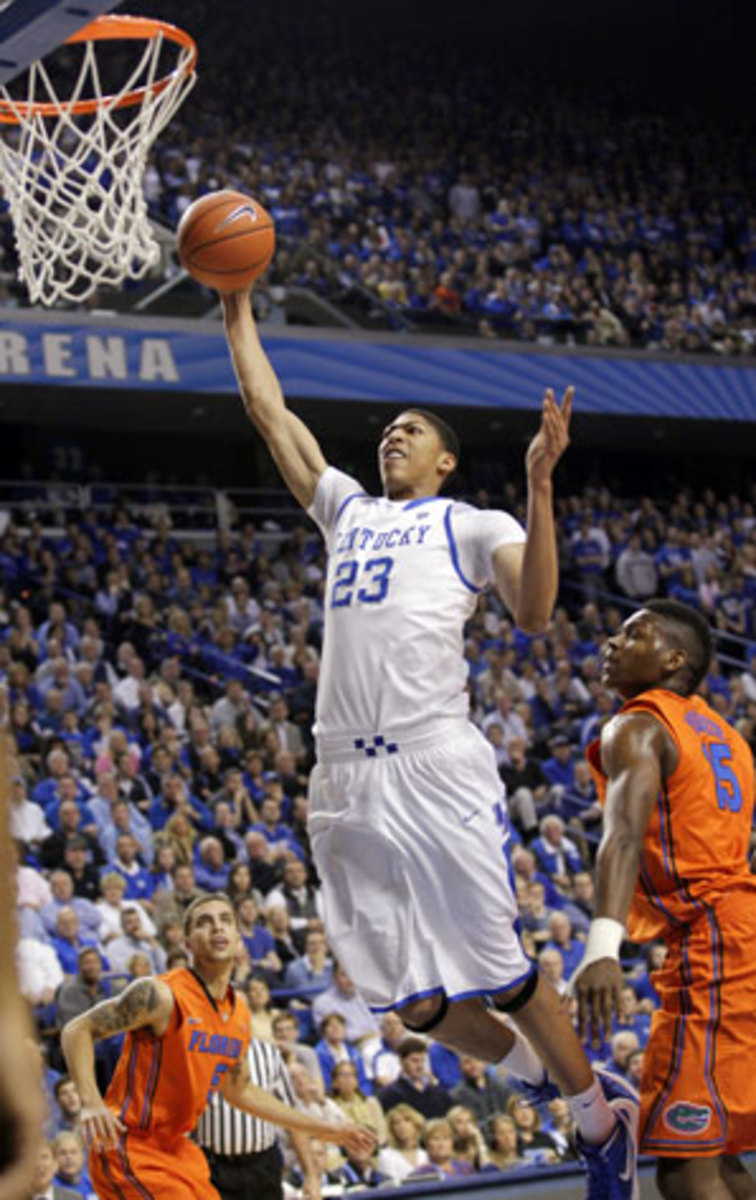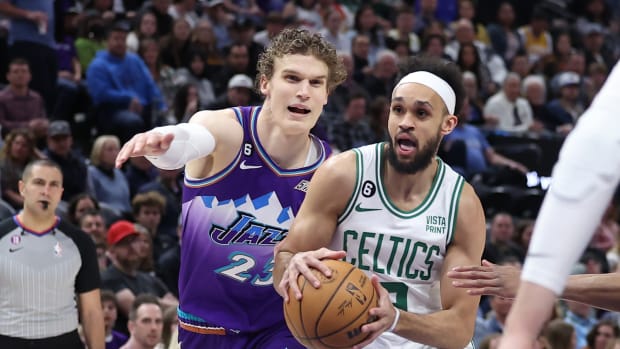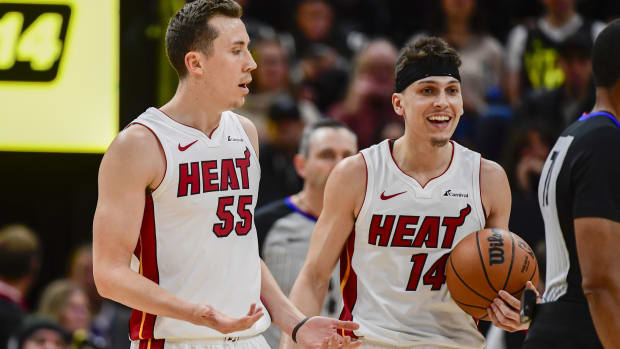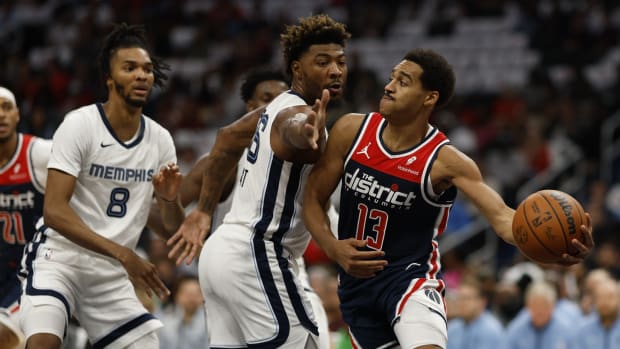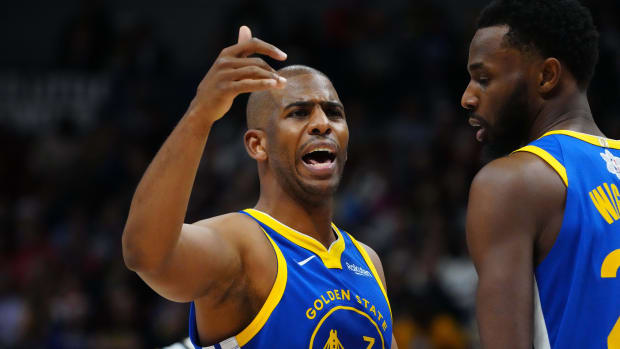Top pick? Biggest sleeper? NBA scouts weigh in on Class of 2012
But something else, arguably more crucial, sparked Kentucky. Freshman wunderkind Anthony Davis blocked two shots down the stretch -- adding to his astronomical total of 127 blocks through Feb. 14 (17 more than any other player in the nation) -- to hold Vanderbilt scoreless over the final 4:52.
"He could play 40 minutes, never score a basket and dominate a game by getting every rebound, blocking shots and altering the ones that he doesn't block," said an NBA scout. "He's a clear-cut favorite to be the first pick."
Davis' meteoric rise -- from a 6-foot-2 junior at Chicago's Perspectives Charter High to the 6-10 projected No. 1 pick in 2012 -- has become the most intriguing storyline in this year's draft. But it's far from the only one. With a month remaining in the college basketball season, here are the answers to nine burning questions through the eyes of a pair of NBA scouts.
In short, yes. At mid-February, Davis hasn't just emerged as a franchise-changing selection; he's separated himself as the unquestioned frontrunner among 2012 NBA prospects, according to the two scouts that spoke to SI.com. Davis' shot-blocking is unparalleled, and his offense is remarkably efficient: He's averaging 14 points despite taking just 8.27 field-goal attempts per game.
While other top candidates have displayed flaws -- UConn's Andre Drummond lacks a back-to-the-basket repertoire; UNC's Harrison Barnes can be one-dimensional at times -- Davis has done nothing but impress. His ball-handling is superior to most bigs (an attribute of his late growth spurt), and he's rapidly improving as a shooter. After making 59 percent of his free throws in his first 13 games, he's hit 78 percent in his last 13.
"Between the skills he has which are readymade -- his length and athletic ability and shot-blocking and rebounding -- and the potential that is yet to be tapped, it's Anthony Davis and everybody else," said one of the NBA scouts. "He's going No. 1."
Beyond Davis, there's no definitive No. 2 prospect. A tier of players should contend for the next pick, the order of whom will be determined by team needs. Among those in consideration: Barnes, Drummond, Perry Jones III, Thomas Robinson and Jared Sullinger.
Robinson and Sullinger appear the most polished of the group -- averaging 18.1 points and 12.1 rebounds and 17.6 points and 9.2 boards, respectively -- but it's important to remember that teams don't draft on readiness. Players like Drummond and Jones, unseasoned but ultra-athletic forwards, boast potential that could be too tantalizing to pass up.
"I think Drummond would probably be on a lot of people's boards, just because his size and athleticism are hard to find," said a scout. "It's hard to find legitimate 'five' men these days, let alone guys who are athletic, big and strong like he is. If I had to pinpoint, I'd probably say Drummond and Barnes will be two and three in some order."
From a purely statistical standpoint, who would you rather have: Player A or Player B?
If you haven't already guessed, Player A is Robinson, Player B Jones. The numbers reflect what's become increasingly evident: With March Madness around the corner, Robinson is playing better, and more inspired, basketball than Jones.
As mentioned above, however, production isn't the only factor in teams' decision-making. Despite Robinson's burgeoning Player of the Year candidacy and upstaging of Jones in both head-to-head meetings (Robinson outscored him a combined 42-23 in two Kansas blowouts), Jones' coveted 6-11 frame and All-Star acrobatics could prove more attractive in June.
"With Thomas Robinson, you kind of know what you're gonna get," said one of the scouts. "But with Perry Jones, his ceiling is so high. He'll make a three and then he'll dunk it in traffic. He's the sexier player, but that doesn't necessarily mean he's gonna be the better player three, six or eight years from now."
"Beauty is in the eye of the beholder," echoed the other scout. "Can you afford to take a risk on a guy like Perry Jones, or do you need somebody you know can step in right away?"
Entering the 2011 draft, Barnes, Jones and Sullinger -- a trio of consensus high lottery picks -- bypassed the NBA draft in favor of a second season on campus. Their decisions marked clear departures from the league's pervasive one-and-done culture, prompting questions about all three players' value.
Four months into the season, the answers have become clear: Returning hasn't affected their value at all.
"Barnes, Sullinger and those guys are still falling in the same range that they probably would've last year," one scout said. "They're still in that three to six or seven range."
The more significant jumps, in fact, have come from Kansas' Robinson and Washington's Terrence Ross, whose stocks have both skyrocketed in recent weeks. Robinson has upped his minutes from 14.6 to 31.3 per game starting in place of the Morris twins, while Ross has blossomed into a sharpshooter for the Pac-12-leading Huskies. His numbers have nearly doubled: He's averaging 31.4 minutes, 15.1 points and 7.0 rebounds this season compared to 17.4, 8.0 and 2.8 in 2010-11.
"[Ross] is a guy that wasn't projected as a first-round pick last year but played himself, in my mind, legitimately into the first round with his athleticism, versatility and ability to guard people," said the other scout. "He'd probably be the guy that stands out the most to me."
The obvious choice here is Drummond, whose skills, though improving, remain a far cry from NBA levels. He's been maddeningly inconsistent -- struggling as UConn lost six of its last seven games -- with scouts criticizing his offensive deficiencies.
"He's a project outside of five feet," one scout said. "Even if you draft him now, he's realistically a couple years away from helping you down the road."
Thing is, Drummond's frame (6-10, 270) and athleticism are exceptionally scarce, all but assuring a top-five selection. The more ideal candidate to return is Quincy Miller, Baylor's 6-9, 210-pound power forward still recovering from an ACL tear in December 2010. Though he's shown flashes of brilliance (20 points, 7-of-10 shooting in a Feb. 11 loss to Missouri), he's averaging a mere five rebounds despite his size, a sign that he's not fully comfortable since coming back from injury.
"Quincy Miller should come back for sure," said a scout. "He's very talented, but from a physical standpoint, hopefully he can regain some of that athletic ability. He looks like's he's still laboring and doesn't have the explosion or burst."
Unlike in the last five drafts, when the top point guard has gone No. 1 three times (Derrick Rose, John Wall, Kyrie Irving) and never lower than No. 5 (Ricky Rubio), it'd come as an overt shock for any of this year's crop to crack the top 10. The 2012 class is notoriously frontcourt-heavy, with UConn's Jeremy Lamb and Florida's Bradley Beal the only guards projected in the lottery of most mocks.
That doesn't mean there aren't some hidden gems. UNC's Kendall Marshall is a gifted passer (though his defense remains suspect), and Texas' Myck Kabongo possesses elite speed (though his decision-making is developing). Weber State's Damian Lillard is perhaps the most intriguing case, leading the nation in scoring (25.1 points per game) in the little-known Big Sky Conference.
But the point guard most likely to go first? That's Tony Wroten Jr., the 6-5, 205-pound freshman out of Washington. He's scored in double-figures in 23 of 25 games, and ranks among the top five in the Pac-12 in points (16.4), assists (3.5), steals (1.9) and field goal percentage (47.1). He's also been phenomenal getting free throw line -- earning 188 attempts, second among major conference players -- and has wowed evaluators with his surprising versatility.
"When we saw him in some of the high school All-Star games, he was really a pass-first guy," said one of the scouts. "But at Washington, he's been a really prolific scorer. I saw a comparison to Tyreke Evans -- capable of getting assists, but always in that attack, wanna score mode."
While most of the national attention focuses on projected lottery picks, there's typically a player or two who slips through the cracks. Despite interminable speculation, even NBA evaluators miss, as with DeAndre Jordan in 2008 (No. 35 pick) and Landry Fields in 2010 (No. 39).
This year, that second-round sleeper could be Marquette's Jae Crowder. The 6-foot-6, 235-pound forward lacks first round size, but still possesses the skills needed to contribute at the next level. He's spearheaded the Golden Eagles to a 21-5 record (10-3 in the Big East) and, after notching double-doubles in four of his last eight games, is starting to creep onto the NBA radar. He compensates for unremarkable athleticism with physicality, court-savvy and effort.
"I don't even know if he's gonna show up on a draft board," said a scout. "But every night, [Crowder] gets 16 points, six or seven rebounds, two steals, a blocked shot and takes a charge. He's clearly helped himself."
There's also William Buford, Ohio State's senior leader. He's gone overlooked despite shooting more than 44 percent since his sophomore season (including 40 percent from distance), and could certainly provide a three-point shooting spark for a contending team.
"He's playing in the shadows, to some degree, of those other guys at Ohio State," one scout said. "I think he would be a great value pick in the second round, and he could potentially sneak into the first. He's a veteran, can post up and can shoot threes."
The most significant drop belongs to Alabama's Tony Mitchell, who plummeted from a fringe lottery to a likely undrafted selection over the past two months. He averaged 15.2 points per game and garnered Puerto Rico Tip-Off tournament MVP honors during his stellar stretch through December, but averaged just 8.3 points in his last six games before being sentenced to an indefinite team suspension for unspecified reasons on Feb. 6. It's caused evaluators to question his maturity -- and dismiss his first round potential.
"That's obviously a red flag for us," said an NBA scout. "If this discussion were Dec. 15, he'd have been in the first round. You don't like suspending your best player, so it must have been fairly egregious for that to have happened."
Then there's Terrence Jones, Kentucky's sophomore enigma. He's been wildly erratic despite his team's success, and has routinely underwhelmed in season-defining contests. Jones' performances against UNC, Indiana, Louisville and Florida are listed below, exemplifying -- and perhaps permeating -- growing concerns about his malaise.
"You would think that he would see how hard [Michael] Kidd-Gilchrist plays and how hard Davis plays and realize he needs to step up his game," said a scout. "But he mentally checks out. If he's doing that at the college level, imagine what he's gonna do once he gets paid."
After being mired in obscurity for most of their college careers, mid-major prospects stand the most to gain in March. While major conference programs play quality competition all season, players like Lillard, Iona's Scott Machado and Tennessee Tech's Kevin Murphy -- who dropped an NCAA-high 50 points against SIU-Edwardsville on Jan. 30 -- could solidify their stock by qualifying for the tournament. A dominant first-round performance accomplishes two goals: providing national recognition and dismissing doubts about their talent.
"We'll be hoping and praying that they get in so we can see them at least in a first-round game against better players," said one of the scouts.
Outside of that group, players like Florida's Patric Young, Mississippi State's Arnett Moultrie and Illinois' Meyers Leonard could significantly benefit from deep tournament runs. All three have pro-caliber size and mobility, and a series of clutch outings could separate them from a currently indistinguishable cluster of bigs.
"It's almost like you have the top eight picks and they're not gonna move around too much," said the other scout. "But if there's a guy that's gonna jump higher, it might be someone like Meyers Leonard. If he has a good tournament, he could really boost his stock."






























